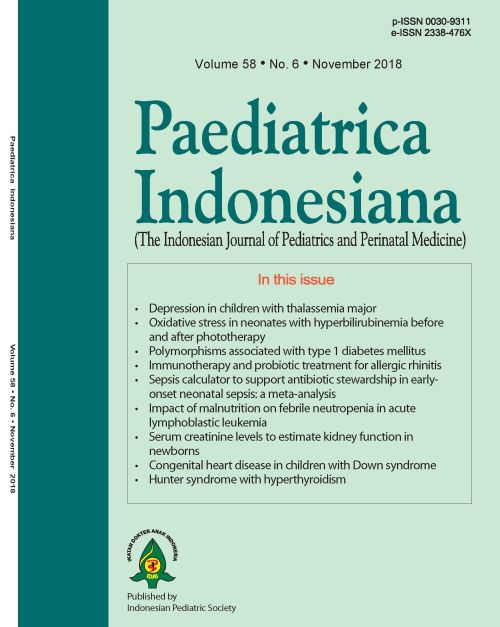Polymorphisms associated with type 1 diabetes mellitus
DOI:
https://doi.org/10.14238/pi58.6.2018.274-9Keywords:
T1DM; PTPN22-1123 G>C; CTLA-4 49A/G; PCR-RFLP; polymorphismAbstract
Background Type 1 diabetes mellitus (T1DM) is an organ-specific autoimmune disease characterized by T cell-mediated destruction of pancreatic islets. The genetic factors involved consist of at least five vulnerability genes: HLA, INS, CTLA-4, PTPN22, and IL2RA/CD25.
Objective To investigate for associations of PTPN22-1123 G>C SNP and CTLA-4 +49A/G polymorphisms with T1DM.
Methods Case and control groups underwent CTLA-4 +49A/G gene examination from June to December 2017, using polymerase chain reaction-restriction fragment length polymorphism (PCR-RFLP) analysis.
Results The study population consisted of 30 T1DM patients and 30 healthy subjects with no family history of diabetes or autoimmune diseases. With regards to the PTPN22-1123 G>C SNP, significantly more subjects with T1DM had the GC genotype than the GG genotype (OR 7.64; 95%CI 1.48 to 39.29; P=0.007). For the CTLA-4 +49A/G polymorphism, although the total number of G alleles in the case group was more than that of the control group (OR 2.286; 95%CI 0.804 to 6.945; P=0.118), there were no significant relationships between the frequency of G alleles (P=0.248) and genotypes GG or AG (P=0.293) with the incidence of T1DM. However, the PTPN22-1123 G>C SNP had a significantly positive association with T1DM, and may be considered as a risk factor for T1DM. In contrast, the CTLA-4 +49A/G polymorphism was not recognized as a risk susceptibility factor for T1DM.
Conclusion These study confirms an association between PTPN22-1123 G>C SNP and T1DM, but no significant association between CTLA-4 +49A/G polymorphism and T1DM.
References
Bluestone JA, Herold K, Eisenbarth G. Genetics, pathogenesis and clinical interventions in type 1 diabetes. Nature. 2010;464:1293-300. https://doi.org/10.1038/nature08933 PMid:20432533 PMCid:PMC4959889
Kitabchi AE, Umpierrez GE, Murphy MB, Barret EJ, Kreisberg RA, Malone JI, et al. Hyperglycemic crises in patients with diabetes mellitus. Diabetes Care. 2003;26Suppl 1:S109-S117. PMid:12502633
Bottini N, Vang T, Cucca F, Mustelin T. Role of PTPN22 in type 1 diabetes and other autoimmune diseases. Semin Immunol. 2006;18:207-13. https://doi.org/10.1016/j.smim.2006.03.008 PMid:16697661
Kawasaki E, Awata T, Ikegami H, Kobayashi T, Maruyama T, Nakanishi K, et al. Systematic search for single nucleotide polymorphisms in a lymphoid tyrosine phosphatase (PTPN22) gene: association between promoter polymorphism and type 1 diabetes in Asian populations. Am J Med Genet A. 2006;140:586-93. https://doi.org/10.1002/ajmg.a.31124 PMid:16470599
Viadya B, Pearce S. The emerging role of the CTLA-4 gene in autoimmune endocrinopathies. Eur J Endocrinol. 2004;150:619-26. https://doi.org/10.1530/eje.0.1500619
Jonson CO. The importance of CTLA-4 and HLA Class II for Type I Diabetes Immunology. Faculty of Health Sciences, Linkoping University. Swedia. 2007.
Celmeli F, Turkkahman D, Ozel D, Akcurin S, Yegin O. CTLA-4 (+49A/G) polymorphism and type I diabetes in Turkish children. J Clin Res Pediatr Endocrinol. 2013;5:40-43. https://doi.org/10.4274/Jcrpe.879 PMid:23367498 PMCid:PMC3628391
Ferreira ACS, Gomes KB, Sampaio IBM, de Oliveira CV, Pardini VC, Godard ALB. Type I diabetes susceptibility determined by HLA alleles and CTLA-4 and insulin genes polymorphisms in Brazilians. Arq Bras Endocrinol Metab. 2009;53:368-73. https://doi.org/10.1590/S0004-27302009000300012
Nistico L, Cascino I, Buzzeti R, Pozzilli P. CTLA-4 in type 1 diabetes mellitus. Madame Curie Bioscience Database Austin: Landes Bioscience; 2000-2013. p. 1-6.
Kavvoura FK, Ionnidis JP. CTLA-4 gene polymorphisms and susceptibility to type 1 diabetes mellitus: a Huge review and meta analysis. Am J Epidemiol. 2005;116:3-16. https://doi.org/10.1093/aje/kwi165 PMid:15961581
Al-shehmany AS, El-Kafoury AA, Haroun M, Embaby AM. Evaluation of CTLA-4 gene polymorphism SNP 49 G/A association with diabetes mellitus type 1 in Egyptian population. Iraqi J Sci. 2014;55:1547-52.
Saleh HM, Koeleman B, Szenasi G, Rosivall L, Hamar P. Association of CTLA-4 polymorphism with type 1 diabetes in the Egyptian population. J Diabetes Metab. 2013;4:291.
Kamel A, Mira MF, Mossalham GI, Ebid GTA, Radwan ER, Eldin NHA, et al. Lack of association of CTLA-4 + 49 A/G polymorphism with predisposition to type 1 diabetes in a cohort of Egyptian families. Egypt J Med Human Genetics. 2014;15:25-30. https://doi.org/10.1016/j.ejmhg.2013.09.002
Saleh HM, Rohowsky N, Leski M. The CTLA-4-819 C/T and +49 A/G dimorphisms are associated with Type 1 diabetes in Egyptian children. Indian J Human Genet. 2008;14:92-8. https://doi.org/10.4103/0971-6866.45001 PMid:20300303 PMCid:PMC2840795
Liu J, Zhang HX, Feng GY, He L. Significantly association of diabetes mellitus with CTLA-4 gene polymorphisms based on a meta-analysis of epidemiological evidence in Asians and non--Asians. Genet Mol Res. 2013;12:3919-30. https://doi.org/10.4238/2013.September.23.11 PMid:24085454
Downloads
Published
How to Cite
Issue
Section
License
Authors who publish with this journal agree to the following terms:
Authors retain copyright and grant the journal right of first publication with the work simultaneously licensed under a Creative Commons Attribution License that allows others to share the work with an acknowledgement of the work's authorship and initial publication in this journal.
Authors are able to enter into separate, additional contractual arrangements for the non-exclusive distribution of the journal's published version of the work (e.g., post it to an institutional repository or publish it in a book), with an acknowledgement of its initial publication in this journal.
Accepted 2018-12-10
Published 2018-12-13


















